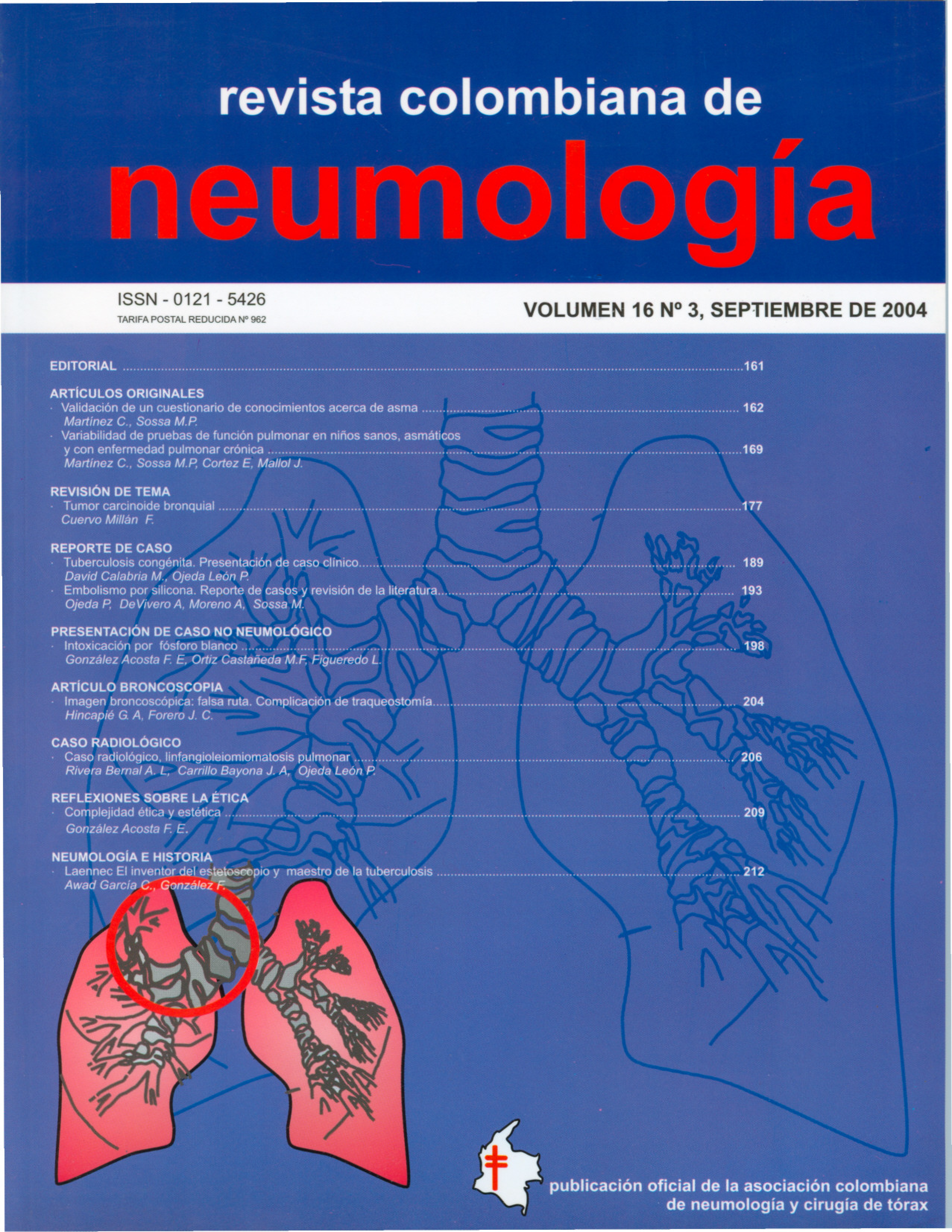Intoxicación por fósforo blanco
Intoxicación por fósforo blanco

This work is licensed under a Creative Commons Attribution-NonCommercial-ShareAlike 4.0 International License.
Ninguna publicación, nacional o extranjera, podrá reproducir ni traducir sus artículos ni sus resúmenes sin previa autorización escrita del editor; sin embargo los usuarios pueden descargar la información contenida en ella, pero deben darle atribución o reconocimiento de propiedad intelectual, deben usarlo tal como está, sin derivación alguna.
Show authors biography
White phosphorus, the form of elemental phosphorus still used as a rodenticide in some parts of the world, is highly poisonous, a human ingestion of 50 mg or 1 mg/kg. may be fatal (7). In Colombia white phosphorus is used as pyrotechnics “totes” in Christmas time.
When used as a rodenticide, is usually mixed with molasses or peanut butter and spread on bread as bait for rodents or roaches. For obvious reasons, rodenticides deployed in this manner may be unintentionally ingested by children or compromised adults. Contact with white phosphorus causes second and third degree skin bums within minutes to hours.
White phosphorus is most immediately toxic to the gastrointestinal tract and liver and ingestion are usually followed by a peculiar type of vomiting, described as “smoking”, luminescent, and with a garlicky odor. Resultant stools may also be luminescent and “smoking” (2).
Delirium, coma, and death from cardiovascular collapse may ensue. White phosphorus has a direct toxic effect on the myocardium and peripheral vessels. Experimentally, acute phosphorus poisoning depresses rat myocardial protein synthesis (3).
Patients who survive the acute effects of white phosphorus poisoning may then have a relatively symptom-free period lasting for a few weeks, only to experience a third stage of systemic toxicity involving the gastrointestinal tract, liver, kidney, and central nervous system.
Treatment for white phosphorus poisoning in the past and present has included orogastric lavage with potassium permanganate 0.1% solution, or 3% hydrogen peroxide diluted to a 2% solution to oxidize the phosphorus to harmless phosphates, followed by the use of activated charcoal and possibly a cathartic. These approaches have not been adequately investigated. Neither corticosteroids, which had been previously recommended, nor exchange transfusions appear to be useful; in one group of 49 suicidal patients from Colombia, corticosteroids did not prevent coma or death from hepatic injury. In another group of 15 patients with hepatic encephalopathy, 3 of 5 patients treated with exchange transfusions survived as compared to 3 of 10 untreated patients (4).
Article visits 65 | PDF visits 41
Downloads
- Simon FA, Pickering LK: Acute white phosphorus poisoning. JAMA 1976; 235:1343-66.
- Goldfrank Lewis R: Goldfrank's Toxicologic Emergencies. Mc Graw Hill. New York. 2002.
- Talley RC, Linhart JW: Acute elemental phosphorus poisoning in man: Cardiovascular toxicity. Am Heart J 1972; 84: 139-40.
- Marin GA, Montoya CA, Sierra JL, Senior JR: Evaluation of corticosteroid and exchange transfusion treatment of acute white phosphorus intoxication. N Engl J Med 1961; 284: 125-28.
- Lee W: Acute Liver Failure.N Engl J Med 1993;329(25):1862-72.
- Martin Paul, Friedman Lawrence: Treatment of chronic hepatic disease. Med Clin North Am. 1996; 80:5.
- Brown AN, Scheiner LB: Evaluation of bilirrubin in a liver screening panel. JAMA 1992; 268:1542.
- Reichling JJ, Kaplan MM: Clinical use of serum enzymes in liver disease. Dig Dis Sci 1988; 33:1601.
- O'Grady JG, Alexander GJ: Early indicators of prognosis in fulminant hepatic failure. Gastroenterology 1989; 97:439-45.
- Ellenhorn MJ, Berceloux DG: Medical toxicology. Diagnosis and treatment of human poisoning. Elsevier Science Publishing. New York. 1988.
- Velásquez Infante: Insuficiencia Hepática Aguda. Rev Cubana Med 2001; 30 (Supl):63-70.
- Riordan Stephen, Williams Roger: Treatment of hepatic encephalopathy. N Engl J Med. 1997; 337 (7):473-79.
- Pietras RJ, Stavrakos: Phosphorus poisoning stimulating acute myocardial infarction. Arch Intern Med 1968; 122:430-34.
- Butterworth RF, GiguereJF : Ammonia: Key factor in the pathogenesis of hepatic encephalopathy. Neurochem Pathol 1987;6:1-12.
- Mullen KD, Szauter KM: “Endogenous" benzodiazepine activity in body fluids of patients with hepatic encephalopathy. Lancet 1990;336:81-3.
- Fischer JE, Baldessarini RJ: False neurotransmitters and hepatic failure. Lancet 1971; 2:75-80.
- Krieger D, Jansen O, Gass P: Manganese and chronic hepatic encephalopathy. Lancet 1995; 346:270-74.
- www.intermedicina.com/Avances/Clinica/ACL22.htm. Insuficiencia Hepática Fulminante Aguda.
- Marik PE: Toxicology. Handbook of evidence based critical care. First Edition. New York. Springer. 2001.
- Dreisbach Robert, True Bev-Lorraine: Dreisbach's Handbook of poisoning: prevention, diagnosis and treatment, 13. Edition. Parthenon Publishing Group. 2002
- Singh S: Phosphide ingestion, a clinic-pathologic study. J Toxicol Clin Toxicol. 1996;34:703-10. VOLUMEN 16N°3
- Chyka PA: Clinical toxicology. Pharmacoterapy: A pathophysiologic approach. 5. Edition. New York. Mc Graw Hill. 2002.
- González A Francisco: Guías para el manejo de pacientes intoxicados en el Servicio de Urgencias. Hospital Santa Clara ESE. Bogotá — Colombia. 2004.6







